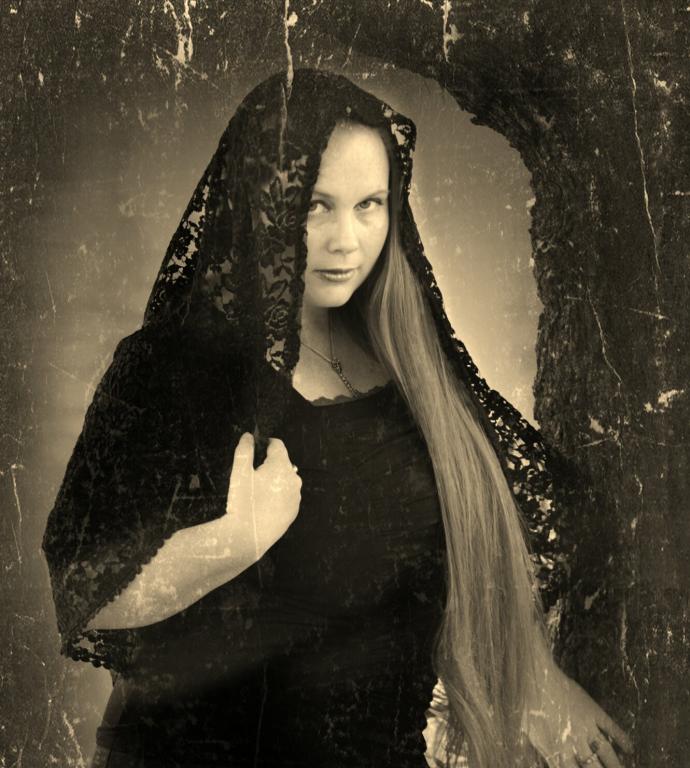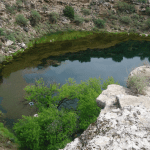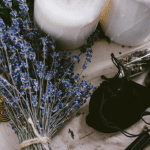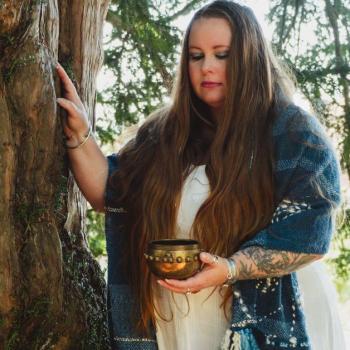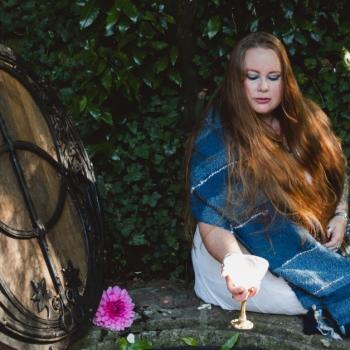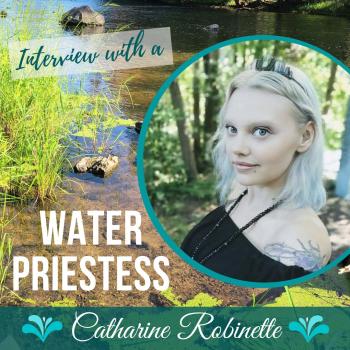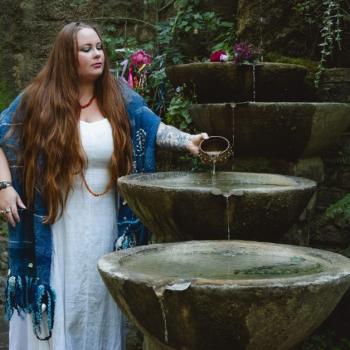Hello Readers!
I am excited to bring you another Interview with a Water Priestess I have been a fan of Laurelei’s work for some time. I am sure you can imagine my excitement when I received a message from her on Instagram. Laurelei received an advanced copy of The Way of the Water Priestess. She then reached out to tell me how inspired she was by my work and how much she enjoyed it. So it is my pleasure and deep honor to share her work with you today! Laurelei is a published author with multiple books about Aphrodite and other esoteric topics as well as a devoted Priestess of Aphrodite, Brighid and her local waters. Grab a cup of tea, sit back and enjoy this lovely interview!
Who are you and how do you practice?
My name is Laurelei Black, and I currently live in Louisville, KY. I say “currently” because, while I have been here for five years and have no plans to leave the area, I have found that the tides of my life have sometimes swept me into new and unexpected places when I least looked for a change. As a child and later as an adult, I lived all over the US (including the deep South, Southwest, Midwest, and Los Angeles) — and even on the coast of the North Sea in Germany.
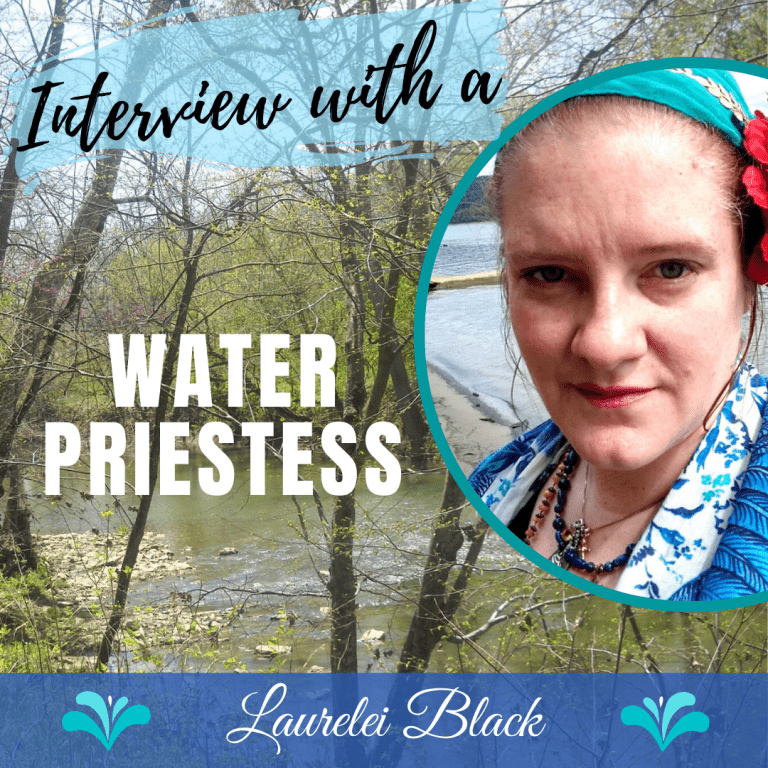
What is your path? And how does it relate to your Water caretaking?
There are two major aspects to my spiritual path that are deeply interconnected, though I think the ways in which they flow into each other are not always evident to most people who don’t also walk similarly complicated paths. I describe myself as both a Witch (practicing a folkloric, pre-modern type of traditional Craft that I call American Folkloric Witchcraft) and a Priestess of Aphrodite and of Brighid. I’ve known myself to be a Witch since I was in my early 20’s, and my practice of the Craft has infused every aspect of my life and worldview. It was through the Craft that I was ultimately dedicated to the service of both Aphrodite and Brighid, both of whom are unmistakably Water Goddesses. They have pulled me, in their service, to oceans and wells and rivers to do Their work — and shown me many Mysteries therein.
How do you think your path brought you here into this specific role?
You know, it’s only been recently that I had the realization that the term “Water Priestess” applies to me. It seems so obvious now, but I have always seen myself in service to specific Goddesses — or identifying with specific spirits — and it wasn’t until I was reading a piece of writing by Annwn where she mentioned several of my prominent Goddesses together that I realized just how immersed I really am in it!! To use a dated reference: It’s like Palmolive. I’ve “been soaking in it!” So, I can’t say that my path “brought” me here, as much as perhaps I recognized that “this is where I live.”
Do you identify as a Well Maiden, Priestess, Caretaker or Witch?
I identify as both a Witch and Priestess, though the context and the work I’m doing play a factor in the term I use for myself at any given moment. The Craft tradition in which I currently practice, for instance, doesn’t use the term “Priestess” as a title. I definitely work with the Water as a Witch, and I work with it as a Priestess of Aphrodite and of Brighid — and as a Water Priestess, unique and distinct from other roles, I’d say. But just like water flows from little streams to bigger rivers to the vast oceans, and like the world’s waters participate in the ever-circling dance of evaporation-condensation-precipitation, nothing I do seems to stay in nice, neat little boxes. It all swirls and mixes and flows together eventually.
What brought you to this sacred water path?
I feel like the energy first signaled the way — gave me the first nudges in this direction, as it were. But walking the path of a Water Witch and Priestess to these Goddesses was very, very Spirit-led. I just knew so little about Spirits or Goddesses in the beginning, that I think they had to use the energy to get my attention! Some of my first explorations along a Pagan/magical path were within the Avalonian path, and I was a member of the Sisterhood of Avalon back in the late 90’s. In fact, my connection to that work was so strong, and my links to the Ladies of the Lake so formative that I still wear the (original minting) Tor Stone pendant as part of my sacred talismans. I had a deep, deep draw to Traditional Witchcraft, though, and both practices required students of my level to dedicate time and attention to focused study — and I chose the Craft, where I heard a song of my Soul and whispers of mysteries hidden in sky, stone, and sea. It took me a long time to recognize the pattern, but mysteries of the sea (and the well and the chalice and the blood) — those watery magics and the Spirits who guard them — were always primary for me. Every Goddess who has stepped forward in a tutelary way has been undeniably associated with Water. Most Spirits who have allied themselves with me have watery connections. Even my name! The Lorelei is a German river Spirit, often envisioned as a woman high up on a rock in a bend of the Rhein, brushing her hair and distracting river-farers to their peril.
Do you have a Sacred Body of water you tend?
There are two sacred Waters with which I currently work. One is Indian Creek which runs through Camp Midian — a festival and event facility I helped found in 2014 in southern Indiana. The other is the Ohio River, which borders the city where I live. Both are part of the Ohio River Basin, a massive network of tributaries and streams (covering 15 states) that feed into the large namesake of the Ohio River.
Are there any specific mineral compounds in the water that make it unique?
Both are here in the Ohio River Valley, and are part of a network of karst features on which this entire part of the country sits. That means limestone, and lots of it! Midian is in the same county as Bedford (a town whose name is synonymous with limestone, for many people). The Empire State Building was quarried from Bedford stone. Midian was itself one of the active quarries in the county, and the creek was integral to the operation. Water flows through the rock there in simply incredible ways! Both Kentucky and Indiana (and Ohio and Missouri) pretty much sit on solid limestone, so all our sacred Waters are blessed with limestone’s kiss. Limestone filters out iron and leaves a decent amount of calcium in water — which is evidently great for both bourbon and horses (and Louisville-dwelling river witches … who also enjoy bourbon — and horses).
What types of spirits dwell here?
As with most places in the sacred landscape, there is an intricate ecology of Spirits associated with both of these bodies of water. I myself am one of those Spirits, coming back to the waters through service, kinship, and love. I tend to work very directly with the Spirit of the creek/river, though I’m aware of the beings who inhabit the parts of the water nearest where I access them. I started by introducing myself and offering blessing and healing. My early work was about observation and play, and giving me and the river/creek Spirit a chance to attune to each other. At Indian Creek (Midian), my work has also been about understanding the extent to which the water wishes to interact with our human community, and then to help facilitate that among the people of Midian.
What type of work (spells, rituals, magic etc) do you do there?
All manner of work is possible at these sites, but I tend to be limited in what I’m able to do based on access. Both are public waterways. Indian Creek (Midian) is located three hours from my home, so I can’t access those waters easily. I’m there with the community for festival gatherings, and with the other staff members for work weekends. Sometimes I’m also on the land and at the water for a private retreat. I perform an annual bathing ritual for Aphrodite called the Aphrodisian there. I’ve done personal cleansing work and some spell work with the creek as an ally. I do a great deal of intuitive working with these waters. My relationship with the Ohio River is newer, and I access it from very public access points. I primarily perform water blessings with the Ohio — and do cleanup along the river’s edge when I visit. It is a strong and powerful but mistreated waterway. I can feel the pollution and see the carelessness of the trash that my neighbors have left on the banks of this green/brown Sister that we take for granted.
What dangers does your body of water currently face? Any perceived threats in the future? Are they Sacred Bodies of water or are you working to shift the energy to something more sacred?
I tend to be of the mindset that the landscape is inherently sacred, and it is only us as humans who fail to recognize that and need to be brought back into harmony and alignment. Yes, the landscape can become polluted (both physically and on other levels), just as we can. But this doesn’t strip them of their inherently sacred nature, anymore than malnutrition and abuse would render you or I less than sacred. In cases like this, I see the landscape as sacred but mistreated by its recent/ongoing/current stewards. I believe all rivers and creeks are inherently sacred, as is the rest of the natural landscape. I’m not sure we have the ability to truly desecrate these primal powers. They are/have Spirits in their own right, and it isn’t us who gives or removes their sanctity. We can only consecrate or desecrate the works of our own hands — tools, temples, etc. We can certainly pollute the world and its many sacred wonders. We can sicken and sully ourselves and our fellow Spirits, but that isn’t the same as unmaking what is sacred.
The Ohio is noticeably polluted, and the areas I’m able to access need cleanup every time I go. I consider this an act of service and love — as a physical blessing, I can give while I perform the energetic one. But again, she is a powerful, broad river, that exudes confidence, and gets business done in a friendly Midwestern way. (She’s got that sort of personality.) The waterways in the Ohio River Basin all face similar threats of pollution, toxic algae blooms, invasive aquatic species, and habitat destruction. This is certainly true for both the smaller stream and the mighty river with which I work. Indian Creek has some limited agricultural runoff, but it is a lovely rural creek — as picturesque as you could hope. She’s hard to reach and temperamental in the spring, but she brings a smile to your Soul just to see the sun glint on her ripples. One feels blessed in the presence of both of these beings.
What is the goal of your work there?
Currently, my goals for the Water itself have been focused on clean-up and personal engagement, as well as educating those within my reach about engaging with the Water in a more responsible way. For me, this includes educating them about best practices when performing rituals or making offerings. I teach folks not to put anything in the water that didn’t start there — or from its bank/shore. No lovely (pesticide and fertilizer filled) flowers. No votive beads or statuary or anything else that is a foreign body — and ultimately more chemical-laden trash for the water to attempt to process on our behalf. These are not gifts.
Do you provide healing rituals for people in, around or connected to your sacred body of water?
Yes, I have done a number of healings and personal rituals (as well as group rituals related to Aphrodite) at Indian Creek at Midian for our Midianites. I often have to bring the water to the seeker, as it can be tricky and treacherous to access this creek, at times. Only rarely have I taken people into this water, mainly for their safety in accessing it. I haven’t done any such work with the Ohio River on behalf of myself or others. My work at this place in service to the Water and Deity, but not so much to people. (At Midian, my service is also very much to the Community, as it is a place built for people to gather together with each other and with the Powers.)
Can you tell us more about the rituals you perform with this water?
My personal workings (spells, charms, healings, blessings, etc) are very intuitive at this point and are based on years of Trad Craft practice and study within British, Celtic, Germanic, and American (particularly Ozark/Appalachian) folkways. I sing and whisper and otherwise vocalize with the Water and the person in the ways I am guided. I may use stones or plants/flowers from nearby as focal points or conductors. I create runes and sigils in the Water and on the body. There is a partnership with the Water, and I listen to its guidance and suggestion in the work at hand. For formal rituals, I have specifically led many in Aphrodite’s service (either in the creek or using water retrieved from it). The Aphrodisia is specifically a bathing ritual, in which Her statue is washed and anointed with oil — and Mysteries are imparted. The Katagogia/Anagogia cycle of rituals are an arrival/departure (descent/ascent) that was historically held at the harbor and heralds the coming and going of Aphrodite. I like this one in my special creek (where small boats pass all summer), with leaf and stick boats as a prelude to the full invocation (channeling) of the Goddess.
How do you feel about the current attack on water? Standing Rock? And Pollution in general?
I’m both heartbroken and enraged over the unrelenting damage contemporary society seems intent to do to our planet — and to the Water specifically. There is a growing awareness that we must change our practices and our policies, but I fear that we (as a species) may come to a place of real repentance too late. (Some of us are too selfish to admit our error, even in the face of catastrophe.) Oof. That’s pretty doomy-gloomy for an Aphrodisian Priestess! (Remember, though: Aphrodite feels deeply, and she was worshipped as a battle Goddess at her earliest holy centers. So rage and heartbreak are part of her arsenal.)
Do you feel that your work is connected to this?
Yes. I’m still figuring out in what way to best serve, but yes definitely. Aphrodite and Brighid are both Water Goddesses, and they are also both deeply loving (and surprisingly fierce) caretakers of so many people, animals, and issues. I mentioned at the top of the interview that I only recently had the insight that my devotion to Them (and my work with other Water Goddesses and Spirits) put me really distinctly in the Water Priestess category myself. I’ve focused a great deal over the years on women’s empowerment, sex and body positivity, and supporting the disability community, but I find myself at a starting place with how best to serve in terms of the fight for the world’s waters.
Do you participate in water activism?
Yes, in the ways I have identified as being within my reach right now. I have donated to groups and organizations who had/have “boots on the ground” for protests and campaigns. I do some education within my own sphere of influence. I boost the signal on posts when I’m online (which is rarer for me). I include water protection in my regular prayers to my Goddesses, and I join in the rituals Annwn organizes.
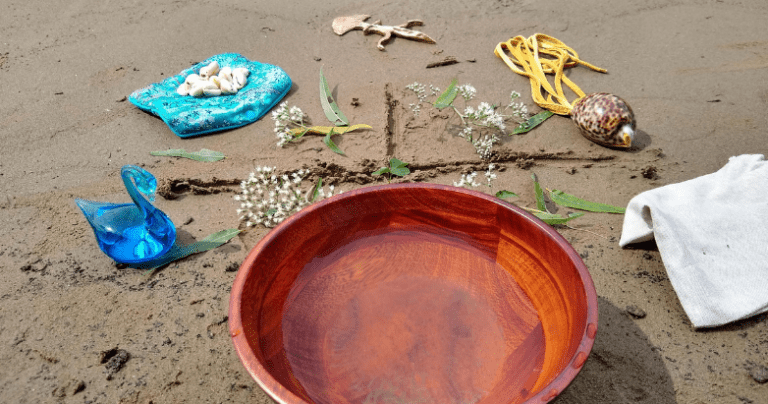
Tell us a little more about what it means to be an Aphrodite Priestess. What has that looked like for you?
Aphrodite is an immense Goddess. She’s vast like the sea from which she was born. Vast like the starry heavens, which is Her other domain. I have spent more than 20 years now getting to know what it means to an Aphrodite devotee and (ultimately) Priestess, and I feel in some ways like I am still only scratching the surface. I was dedicated into Her service in 2001, as a “Simple Priestess” (meaning, not a HIGH Priestess, yet) within my Craft tradition, and I had already been doing scholarly and practical work for a couple of years. The scholarly work looked like research and writing essays for my coven to read — essays that would grow into both outreach on Yahoo groups and later into my books (Aphrodite’s Priestess , followed by Cult of Aphrodite ). The practical work looked like developing new rituals, reviving ancient rituals, and serving as a conduit for Aphrodite to both my family (husband and baby girl) and coven. Because there weren’t any resources for contemporary Aphrodite devotees at that time (and there are still very few — although I’m grateful there are more now that others have started sharing their practice, too), I decided to collate my own work into that first book. The first edition was called In Her Service: Reflections from a Priestess of Aphrodite . (When I expanded and revised it a few years later, I simplified the title; but you can still see that first edition floating around.) In it, I shared the insights and guideposts I had found thus far for embarking on a devotional relationship with the Goddess of Love, the Heavens, the Ocean, War, and Passion. I also shared what service as a Priest/ex might look like. Because I’m a teacher at heart, a lot of my particular priestessing looks like teaching and facilitating, most of the time. (I was a school teacher for several years. Teaching really is at my core. Part of my Soul’s purpose.) I have been driven to share information and materials to help others develop their own relationships with Aphrodite, and I have facilitated group experiences (workshops, festivals, retreats, rituals, etc) to both deepen their connection to Her and to find others of like mind. Cult of Aphrodite explores a cycle of festivals (seasonal rituals) as well as devotional rites that folks can do to honor and align with Her. Some are ancient rites that I’ve revived or reinvented, while others are purely modern constructs. They run the gamut of light to shadow, dance to dirge, bloom to decay. She is a Goddess who holds all of these within Herself, and to deny any of them would be a disservice to Her (and futility — or at least shallowness — for the devotee). My role as Priestess has taken lots of shapes, though, over 20+ years of service. I have been the courtesan in the temple, a sacred dancer, a healer, a guardian and warrior, a midwife to both life and death, a poet, a sorceress, an artist, a gardener. Sometimes I’ve been clumsy in these roles (and sometimes surprisingly graceful), but Aphrodite’s always put me where I needed to be for my own growth and (often) for helping others.
Tell us a little about Aphrodite’s role as a Water Goddess, and how this influences your practice — or how others might work with her.
According to the oldest Greek version of Her birth story, Aphrodite was conceived when Ouranos (the Titan of the Sky, and father of the Titans) had his genitals severed by his son (Chronos/Time). When the generative bits fell, they landed in the Sea, which began foaming and frothing. Aphrodite emerged from this foam, and some scholarship suggests that her name actually means “foam-born.” (Interestingly, other scholarship suggests that it means “bright cloud,” which also makes sense, given her heavenly/sky realm connections.) Throughout myths and ritual practice all over ancient Greece, we see Aphrodite associated heavily with Water, and most especially with the Sea. However, there are worship centers established for her that are watery, but not sea-centric. These most often involve pools, grottoes, springs, and wells — though streams and rivers weren’t out of the question. Truly, all water was a place to honor Aphrodite and to connect with her, which makes sense when we think about Her story and the metaphysical properties of Water.
Aphrodite’s birthplace is credited as either Cyprus or Cythera, depending on who’s telling the tale. In either case, the waters off the shore of the island saw her birth, and the island itself was the first to be graced with her steps. She returns to the waters of her birth (usually called her “Bath”), on a regular basis for cleansing, rejuvenation, and renewal. She also goes (flees, really) to them for solace and comfort during times of hardship. Both magically and ritually, there is so much here to work with, in terms of developing practices that sustain, fortify, heal, and even indulge us — for surely, those are just some of things Aphrodite herself does within the water.
She also goes to the seashore on a regular basis just to dance with her friends. Aphrodite is often in the company of the Graces, the Muses, the Hours, a veritable tribe of nymphs, her daughters, and other Goddesses. She really values time with her companions, and they are often “dancing” together near water — either her bath or other waters. (“Dance” has a wide meaning in ancient Greek usage. Anything graceful and lovely to watch as it moves is said to dance. Certainly, Aphrodite danced; but she may have also splashed, played, frolicked, cavorted, stretched, and so on. “Dancing” could also be a euphemism for intimacy among the women, as generally speaking, ancient Greek men didn’t care much what ancient Greek women did among themselves — and often didn’t have any idea what that might have been.) Water is the element of sensuality, of emotion, of deep memory, of birth, of comfort, of healing, of intuition, of regeneration — and Aphrodite not only is symbolic of all of these, but she models for us how to access them. By going to the water. By doing our dance — whatever that is for us. And maybe we have to listen to our intuition to figure out exactly how that looks for us. Pouring. Immersing. Washing. Splashing. Offering.
I connect with Aphrodite in my shower and bath because bathing is such a sacred act, especially with her. I perform lustrations, which are ritual bathings/washings, for myself and for others. And sometimes I really sink into this a little extra. For me, there’s nothing like going to the sea! Someday, I’ll move closer to it. For now, my husband and I make pilgrimages.
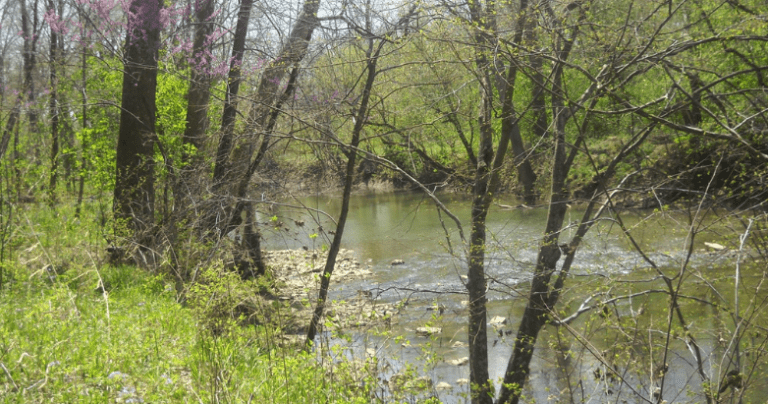
Does Aphrodite have a particular connection, then, to water activism?
Absolutely! Aphrodite is a fighter! The first images of Aphrodite in ancient Greece no longer exist. They were already ancient when the ancient historians were writing their histories. But those first images of Aphrodite were located at Cyprus and at Corinth, and they were armed. Aphrodite had weapons of her own. She was also armed at Sparta. Aside from Venus (who shares so much directly in common with Aphrodite), the other “Love” Goddesses around the globe are also “War” Goddesses. They fight. I have always interpreted this, in part, as two expressions of passion — but also, in part, as Love itself being ready, willing, and able to fight for what it loves. This means that Aphrodite devotees have a high chance to get involved with some sort of activism, in my experience, because they feel so fiercely about the people and ideals they cherish. They are willing to defend them. It’s no coincidence that the sign of Libra (the scales — Justice), is ruled by the planet Venus. There is a strong sense of justice and activism in the Aphrodite-people I know. Water activism is one, very obvious choice for us because of Aphrodite’s deep connection to the Sea (and all waters) — along with combating domestic and sexual violence, transphobia, sexual discrimination, and racism.
What role has Love played in your service to Aphrodite? Can you share with us about Aphrodite as a Goddess of Love?
It was issues of love, lust, sex, and relationship that first helped me identify Aphrodite as an influence in my life. I see that happening with a lot of Her devotees. We get tripped up on one of the Love issues and then have an A-HA moment where we finally see Her clearly. Things aren’t always smooth-sailing after that, but we are better able to navigate the deep waters and stormy seas. Love is a bigger sphere of influence than most people admit or understand. (And Aphrodite’s sphere of influence includes more than “the lovely works of Love,” regardless of what Homer quotes Zeus saying on the matter.) The ancient Greeks had more than one word for Love, and all of them came under Aphrodite’s purview.
Philia – the love we have for close friends
Philautia – self-love
Storge – family love
Eros – physical desire; attraction
Kharis – gracious, reciprocal affection and goodwill
Agape – divine love.
It gets more complicated, in the sense that Eros was also personified — and had a multi-faceted personification in the form of the Erotes (young men with names that meant Longing, Infatuation, Requited Love, etc). And the same is true of Kharis, which we see as the three Kharites, or Graces. So, those expressions of love are all named, embodied, and hang out with Aphrodite as part of her retinue. As a Priestess of a Love Goddess, I am often a servant of Love. For me, this has meant doing public outreach things like teaching about sacred sexuality, holding sacred space for sex and sensuality, teaching about safer sex and consent. It has also meant working on my own relationships with family and friends, being an ambassador of Love to my community, listening to heartaches when I can, and offering sympathy and grace as I am able. It also means loving myself and taking care of myself, so I can do these things for others.
Are you working on any projects right now related to Aphrodite?
I am! There are always things in the works, but my challenge is getting them out to the world. (I need a team. I work well in a collective. Did you know Aphrodite is associated with bees? Her Priestexes, in some places, are called bees — melissae.) So, one goal is to gather a collective of Aphrodite-folks who are interested in learning, growing, and working together. One really cool project that is very near completion is the “Wisdom of Love” cowrie divination system. The system is complete, actually. Has been for years, but I’m almost done with the booklet that will help others learn and use it. I’ve been sharing simple readings on my Instagram and Facebook pages since the beginning of this year, and I am looking forward to getting the booklet out to folks (in print and PDF) through my indie publishing house soon. I’ve been toying with the idea of launching a YouTube channel related to my Aphrodite work. (I have one for witchcraft, and I like the format.) I may start slower — 2 posts/month instead of once/week — until I know if there’s an audience for it. But I feel like maybe folks are ready. I feel ready. I have plans to create a comprehensive training program for Aphrodite Priestexes, as well as mini-courses. These plans have honestly been in the works for a while, but I would really like to get them out and ready. (I have outlines and materials galore. I just need to format and stitch everything together.) So … teaching. Lots of teaching. And when it’s safe to do public appearances again, I’ll be at Midian and other event spaces offering Aphrodisias, Adonias, Arrephorias, and other rituals, as well.


